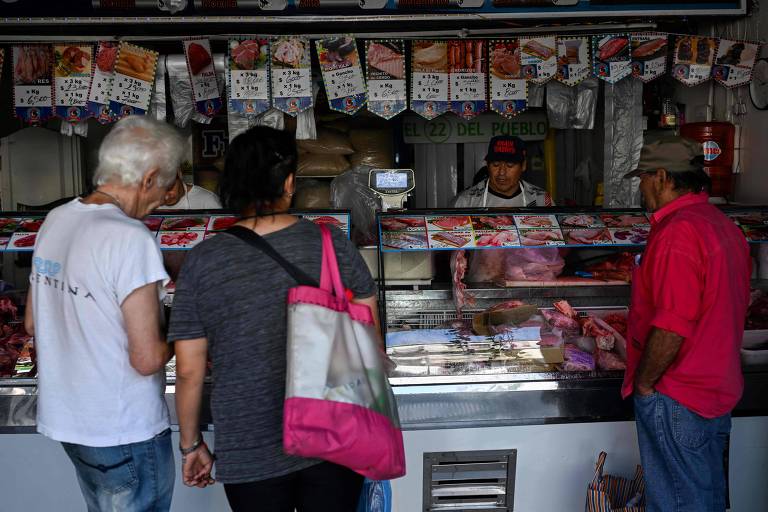With its peso appreciating, Brazil increases sales to Argentina, including meat sales.

While Brazil is waging a war with the United States government to avoid higher import tariffs, Argentina increased its purchases of Brazilian products by 55.4% in the first half of 2025, totaling US$9.1 billion. From January to June, Brazilians sold to their southern neighbors primarily passenger vehicles (21.6%), auto parts and accessories (9.7%), and goods vehicles (6.4%).
But even in traditional products of the country, such as beef , the entry of Brazilian items has increased: it was around US$ 1 million in the first half of last year and rose to US$ 22.9 million in the same period this year.
The data comes from Mdic (Ministry of Development, Industry, Commerce and Services), part of it compiled by Abiec (Brazilian Association of Meat Exporting Industries).
In the case of meat, in terms of volume, Brazilian beef's share in the neighboring market is still small and does not threaten local production. Fresh, chilled, or frozen beef accounts for 0.25% of the total export basket.

Some of the purchases were made by foreign meatpacking plants operating in the country, and the meat had always been imported by them, but was primarily used in processed products such as hamburgers. In 2025, a percentage of imports began to be used for cuts, according to industry representatives in Argentina.
"It's unusual, in the land of meat and barbecue, we're now importing this type of food from our neighbor Brazil," said a presenter on the Crónica TV channel in a May program. "It's cheaper to import than to produce here."
According to the local press, in cities in Patagonia, in the south of the country, a kilo of Brazilian meat in March reached 9,000 Argentine pesos, while Argentine meat cost 22,000.
"Depending on the supermarket, we can find Brazilian sliced bread or Uruguayan milk at better prices than the local ones," says housewife Nérida Arsas, 69, who lives in Buenos Aires.
On the other side of the counter, in the first half of the year, Brazilians purchased US$6.2 billion worth of Argentine products (a 1.6% increase), leading to a US$3 billion surplus in Brazil's favor. And relations between President Luiz Inácio Lula da Silva and Argentina's Javier Milei haven't warmed.
Overall, Argentina began purchasing significantly more from abroad in 2025. In the first quarter alone, imports reached 32% of GDP (Gross Domestic Product), the highest percentage in 135 years, according to a report by the consultancy Argendata. This calculation also includes tourist travel expenses abroad.
The document highlights some key factors driving this movement, such as trade liberalization, with tariff reductions and deregulation, which facilitated the entry of foreign products. This was evident in purchases on foreign e-commerce sites in the auto parts sector.
The appreciation of the Argentine peso against the dollar also made imported goods more affordable, increasing international tourism, including short-term shopping trips to border cities such as Brazil, Chile, and Paraguay. Furthermore, falling inflation made purchase contracts for imported goods and supplies more predictable.
Economist Santiago Bulat, professor at IAE Business School and managing partner at Invecq Consultoria, considers that sales of imported products by Argentina were at a very low level in 2024, during the harshest phase of the shock caused by Milei's measures.
"Imports fell significantly last year, companies still had a lot of debt from old imports, and economic activity grew strongly in the first months of this year, although now it appears to be more stagnant," he says. He adds that import levels have been declining in July.
Even so, the exchange rate, which has gained some competitiveness in recent weeks, remains at a low and accessible level, Bulat adds. "And, with the government's opening, sectors such as textiles, home appliances, and automotive, among others, are competing with foreign products."
Although the macroeconomic environment has stabilized, the increase in imports has had a distinct impact on Argentine companies, especially small and medium-sized ones, with many becoming uncompetitive. More than 11% of exporting companies have stopped selling abroad due to a loss of competitiveness, and 41.3% of SMEs have seen declines in domestic sales.
The IPA (Argentine association of small and medium-sized enterprises) warns that measures to encourage imports, although they have reduced prices, have not been accompanied by policies to protect SMEs, resulting in an increase in unemployment in sectors such as textiles and metallurgy.
"For now, this increase in imports from Argentina appears to be sustainable until the end of the year, although without a strong tax reform, some sectors will suffer more than others, because the tax burden (especially provincial taxes) harms the competitiveness of products manufactured here," Bulat adds.
uol





